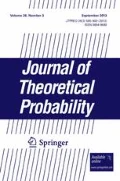Abstract
We analyze random walks on a class of semigroups called “left-regular bands.” These walks include the hyperplane chamber walks of Bidigare, Hanlon, and Rockmore. Using methods of ring theory, we show that the transition matrices are diagonalizable and we calculate the eigenvalues and multiplicities. The methods lead to explicit formulas for the projections onto the eigenspaces. As examples of these semigroup walks, we construct a random walk on the maximal chains of any distributive lattice, as well as two random walks associated with any matroid. The examples include a q-analogue of the Tsetlin library. The multiplicities of the eigenvalues in the matroid walks are “generalized derangement numbers,” which may be of independent interest.
Similar content being viewed by others
REFERENCES
Abels, H. (1991). The geometry of the chamber system of a semimodular lattice. Order 8(2), 143–158.
Aldous, D. (1999). The Moran process as a Markov chain on leaf-labeled trees, preprint.
Bayer, D., and Diaconis, P. (1992). Trailing the dovetail shuffle to its lair. Ann. Appl. Probab. 2(2), 294–313.
Bergeron, F., Bergeron, N., Howlett, R. B., and Taylor, D. E. (1992). A decomposition of the descent algebra of a finite Coxeter group. J. Algebraic Combin. 1(1), 23–44.
Bidigare, T. P. (1997). Hyperplane Arrangement Face Algebras and Their Associated Markov Chains, Ph.D. thesis, University of Michigan.
Bidigare, T. P., Hanlon, P., and Rockmore, D. N. (1999). A combinatorial description of the spectrum for the Tsetlin library and its generalization to hyperplane arrangements. Duke Math. J. 99(1), 135–174.
Billera, L. J., Brown, K. S., and Diaconis, P. (1999). Random walks and plane arrangements in three dimensions. Amer. Math. Monthly 106(6), 502–524.
Billera, L. J., and Liu, N. Noncommutative enumeration in graded posets. J. Algebraic Combin., to appear.
Björner, A., Las Vergnas, M., Sturmfels, B., White, N., and Ziegler, G. M. (1993). Oriented Matroids, Encyclopedia of Mathematics and Its Applications, Vol. 46, Cambridge University Press, Cambridge.
Brown, K. S. (1989). Buildings, Springer-Verlag, New York.
Brown, K. S., and Diaconis, P. (1998). Random walks and hyperplane arrangements. Ann. Probab. 26(4), 1813–1854.
Désarménien, J. (1983). Une autre interprétation du nombre de dérangements. Sém. Lothar. Combin. 8, Art. B08b, 6 pp. (electronic).
Désarménien, J., and Wachs, M. L. (1993). Descent classes of permutations with a given number of fixed points. J. Combin. Theory Ser. A 64(2), 311–328.
Diaconis, P. From shuffling cards to walking around the building: An introduction to modern Markov chain theory, Proceedings of the 1998 International Congress of Mathematicians, to appear.
Diaconis, P. (1988). Group Representations in Probability and Statistics, Institute of Mathematical Statistics Lecture Notes—Monograph Series, Vol. 11, Institute of Mathematical Statistics, Hayward, CA.
Diaconis, P., Fill, J. A., and Pitman, J. (1992). Analysis of top to random shuffles. Combin. Probab. Comput. 1(2), 135–155.
Diaconis, P., and Freedman, D. (1999). Iterated random functions. SIAM Rev. 41(1), 45–76 (electronic).
Fill, J. A. (1996). An exact formula for the move-to-front rule for self-organizing lists. J. Theoret. Probab. 9(1), 113–160.
Greene, C. (1973). On the Möbius algebra of a partially ordered set. Advances in Math. 10, 177–187.
Grillet, P. A. (1995). Semigroups. An Introduction to the Structure Theory, Monographs and Textbooks in Pure and Applied Mathematics, Vol. 193, Marcel Dekker Inc., New York.
Grove, L. C., and Benson, C. T. (1985). Finite Reflection Groups, second ed., Graduate Texts in Mathematics, Vol. 99, Springer-Verlag, New York.
Högnäs, G., and Mukherjea, A. (1995). Probability Measures on Semigroups, Plenum Press, New York, Convolution products, random walks, and random matrices.
Humphreys, J. E. (1990). Reflection Groups and Coxeter Groups, Cambridge Studies in Advanced Mathematics, Vol. 29, Cambridge University Press, Cambridge.
Klein-Barmen, F. (1940). Über eine weitere Verallgemeinerung des Verbandsbegriffes. Math. Z. 46, 472–480.
Orlik, P., and Terao, H. (1992). Arrangements of Hyperplanes, Grundlehren der Mathematischen Wissenschaften, Vol. 300, Springer-Verlag, Berlin.
Petrich, M. (1971). A construction and a classification of bands. Math. Nachr. 48, 263–274.
Petrich, M. (1977). Lectures in Semigroups, Wiley, London/New York/Sydney.
Phatarfod, R. M. (1991). On the matrix occurring in a linear search problem. J. Appl. Probab. 28(2), 336–346.
Schützenberger, M.-P. (1947). Sur certains treillis gauches. C. R. Acad. Sci. Paris 224, 776–778.
Serre, J.-P. (1977). Linear Representations of Finite Groups, Springer-Verlag, New York; Translated from the second French edition by Leonard L. Scott, Graduate Texts in Mathematics, Vol. 42.
Solomon, L. (1967). The Burnside algebra of a finite group. J. Combin. Theory 2, 603–615.
Solomon, L. (1976). A Mackey formula in the group ring of a Coxeter group. J. Algebra 41(2), 255–264.
Stanley, R. P. (1996). Combinatorics and Commutative Algebra, second ed., Progress in Mathematics, Vol. 41, Birkhäuser Boston Inc., Boston, MA.
Stanley, R. P. (1997). Enumerative Combinatorics. Vol. 1, Cambridge Studies in Advanced Mathematics, Vol. 49, Cambridge University Press, Cambridge, with a foreword by Gian-Carlo Rota, corrected reprint of the 1986 original.
Tits, J. (1974). Buildings of Spherical Type and Finite BN-Pairs, Lecture Notes in Mathematics, Vol. 386, Springer-Verlag, Berlin.
Wachs, M. L. (1989). On q-derangement numbers. Proc. Amer. Math. Soc. 106(1), 273–278.
Welsh, D. J. A. (1976). Matroid Theory, L. M. S. Monographs, No. 8, Academic Press [Harcourt Brace Jovanovich Publishers], London.
Whitney, H. (1935). On the Abstract Properties of Linear Dependence, Amer. J. Math., pp. 509–533; Collected Papers, Vol. I, 147–171.
Zaslavsky, T. (1975). Facing up to arrangements: Face-count formulas for partitions of space by hyperplanes. Mem. Amer. Math. Soc. 1(154), vii+102 pp.
Zaslavsky, T. (1977). A combinatorial analysis of topological dissections. Advances in Math. 25(3), 267–285.
Ziegler, G. M. (1995). Lectures on Polytopes, Graduate Texts in Mathematics, Vol. 152, Springer-Verlag, New York.
Author information
Authors and Affiliations
Rights and permissions
About this article
Cite this article
Brown, K.S. Semigroups, Rings, and Markov Chains. Journal of Theoretical Probability 13, 871–938 (2000). https://doi.org/10.1023/A:1007822931408
Issue Date:
DOI: https://doi.org/10.1023/A:1007822931408



